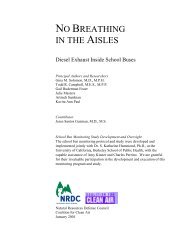US Nuclear Weapons in Europe - Natural Resources Defense Council
US Nuclear Weapons in Europe - Natural Resources Defense Council
US Nuclear Weapons in Europe - Natural Resources Defense Council
You also want an ePaper? Increase the reach of your titles
YUMPU automatically turns print PDFs into web optimized ePapers that Google loves.
U.S. <strong>Nuclear</strong> <strong>Weapons</strong> <strong>in</strong> <strong>Europe</strong> • Hans M. Kristensen/<strong>Natural</strong> <strong>Resources</strong> <strong>Defense</strong> <strong>Council</strong>, 2005<br />
THE 2001 NUCLEAR POSTURE REVIEW<br />
Cl<strong>in</strong>ton Era <strong>Nuclear</strong> Force Unchallenged<br />
One of the Cl<strong>in</strong>ton adm<strong>in</strong>istration’s last acts <strong>in</strong> 2000 was to authorize the cont<strong>in</strong>ued<br />
deployment of 480 nuclear bombs <strong>in</strong> <strong>Europe</strong>, a force level first set <strong>in</strong> 1994. With the<br />
election of President George W. Bush, it was possible that the new president might share<br />
his father’s boldness on unilateral nuclear reductions and would f<strong>in</strong>ish the disarmament<br />
process begun a decade earlier. In a speech to the National <strong>Defense</strong> University <strong>in</strong> May<br />
2001, President Bush pledged that he was “committed to achiev<strong>in</strong>g a credible deterrent<br />
with the lowest-possible number of nuclear weapons consistent with our national security<br />
needs, <strong>in</strong>clud<strong>in</strong>g our obligations to our allies. My goal,” he said, “is to move quickly to<br />
reduce nuclear forces.” 191<br />
One of his first acts as president was to order a <strong>Nuclear</strong> Posture Review (NPR) <strong>in</strong>tended<br />
to br<strong>in</strong>g U.S. nuclear policy more <strong>in</strong>to accord with the <strong>in</strong>ternational and domestic<br />
situation. NATO wanted to be consulted, and as work got under way on the NPR, the<br />
f<strong>in</strong>al communiqué from the NATO NPG meet<strong>in</strong>g <strong>in</strong> June 2001 “expressed <strong>in</strong>terest <strong>in</strong><br />
consult<strong>in</strong>g with the United States on its deliberations to adapt deterrence concepts and<br />
forces to meet future security challenges….” 192<br />
When the NPR was completed <strong>in</strong> December 2001, and parts of it were leaked to the press<br />
a few weeks later, it turned out that the adm<strong>in</strong>istration’s focus had been on <strong>in</strong>corporat<strong>in</strong>g<br />
conventional forces and missiles defense <strong>in</strong>to strategic plann<strong>in</strong>g rather than reexam<strong>in</strong><strong>in</strong>g<br />
nuclear policy. The nuclear posture was not changed significantly compared with that<br />
envisioned under the START III framework agreed between Wash<strong>in</strong>gton and Moscow <strong>in</strong><br />
1997. Concern<strong>in</strong>g the nuclear weapons <strong>in</strong> <strong>Europe</strong>, however, the NPR h<strong>in</strong>ted that there<br />
might be some changes <strong>in</strong> the future. The document mentioned that a NATO review was<br />
under way to present plans to the defense m<strong>in</strong>isters <strong>in</strong> the summer of 2002:<br />
"Dual-capable aircraft and nuclear weapons <strong>in</strong> support of NATO. DoD<br />
will not seek any change to the current posture <strong>in</strong> FY02 but will review<br />
both issues to assess whether any modifications to the current posture are<br />
appropriate to adapt to the chang<strong>in</strong>g threat environment. A plan is already<br />
under way to conduct a NATO review of U.S. and allied dual-capable<br />
aircraft <strong>in</strong> <strong>Europe</strong> and to present recommendations to M<strong>in</strong>isters <strong>in</strong> summer<br />
of 2002. Dual-capable aircraft and deployed weapons are important to the<br />
cont<strong>in</strong>ued viability of NATO's nuclear deterrent strategy and any changes<br />
need to be discussed with<strong>in</strong> the alliance." 193<br />
The NPR <strong>in</strong>cluded language suggest<strong>in</strong>g that plans existed to phase out the F-16 once a<br />
dual-capable F-35 Jo<strong>in</strong>t Strike Fighter (JSF) was deployed. The F-15E, however, with it<br />
considerable range and greater capacity (up to five nuclear bombs), would be reta<strong>in</strong>ed.<br />
All of these plans were subject to further study, but the Operational Requirements<br />
Document (ORD) for the JSF “requires that <strong>in</strong>itial design permit nuclear capability to be<br />
62
















